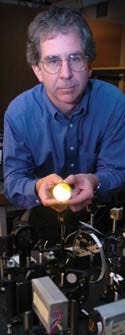Originally Published MDDI July 2004R&D DIGESTHeather Thompson
July 1, 2004
Originally Published MDDI July 2004
R&D DIGEST
|
Purdue physics professor David Nolte holds a prototype BioCD. |
Compact discs may soon serve as diagnostic tools to be used in doctor's offices, or even at home. Instead of holding digitally encoded information such as music, the analog discs would evaluate biological media for protein networks that mark the presence of disease risk.
Scientists estimate that human blood contains more proteins than genomes, i.e., more than 31,000. The study of proteomics examines the function of all the proteins in the human body, and doctors theorize that proteins may hold the key for gene expression, and therefore, genetic disorders. David Nolte, professor of physics for Purdue University (West Lafayette, IN) headed a group of researchers to create the Bio-optical CD to analyze proteins in blood or urine.
Using the CD offers a quick, inexpensive, and comprehensive way to assess the risk of disease onset. Nolte anticipates that “a single disc could eventually assay for hundreds to thousands of sample proteins…the total assay time for a thousand analytes might be as short as 1–2 hours.” This is in sharp contrast to the current method for blood analysis, which requires samples to be sent to a lab for several days and only screens a limited number of proteins at a time.
The difference is in design. Nolte makes use of existing technology from digital media. Tracks or pits on the surface of an ordinary digital CD hold binary data, read as ones or zeros depending on their size. Nolte's team uses the same pits as a series of miniature test tubes. Every pit or track contains a certain chemical that reacts to protein matrices.
The pitted surface is exposed to a media sample and then read by laser technology similar to that found in conventional CD players. Since any regular CD can easily hold up to 10,000 tracks, the researchers can test up to 10,000 different proteins from a sample size of no more than a drop of blood or urine.
Even with a small sample size, the process yields extremely sensitive results. The team measures sensitivity down to ng/ml.
The BioCD technology uses cost-effective materials. Nolte points out that CDs and CD drives are inexpensive to manufacture. With only minor changes, a CD drive could be transformed into a bioassay device. Current assay systems use detection technology such as biochips. Although these systems are promising, Nolte says, they do not screen comprehensively and can cost upwards of $50,000.
Practical use of the BioCD is still a few years away. So far, researchers have used only rabbit and mouse proteins, not human. Nolte says that adequate funding is also an issue. “It is currently funded by the NSF [National Science Foundation], but significant development will require substantially larger funds.” Nolte and his team have a patent on the technology, and Purdue University is seeking to license it to biotechnology companies.
Still, Nolte believes that the affordable manufacturing materials, extreme sensitivity, and quick assessment could eventually place the device in point-of-care situations for use by general medicine practitioners. “Ultimately,” he says, “the BioCD could be a major help in preventive medicine by identifying oncoming disease long before outward symptoms are displayed.”
Copyright ©2004 Medical Device & Diagnostic Industry
About the Author(s)
You May Also Like

